How Much Game Can You Fit in 2.7 Inches?
Conversations with artists pushing the limits of the world's tiniest games console
Games are a very commercialized art form. They’re a bit like movies, where half the conversation is always about the budget and the box office earnings.
Partly this is because games are very expensive and time-consuming to create. Successful releases can also make a lot of money, so both audiences and game developers have become a bit obsessed with the business of games. Sales figures, concurrent player counts, that sort of thing. You often see people lamenting this focus on games as a commercial product. And I get it. Hell, I’m a marketing guy, and even I get tired of all the online chatter about metrics, peak CCU counts, and ever-bigger budgets and launch day records.
So it came as a nice surprise that the people at Panic went out and funded an entire new season of games for the Playdate, their little yellow handheld console with a crank. In an industry where everything is always bigger, the Playdate—with its 2.7-inch, 400x240 black-and-white screen—is the one place left where everything is smaller on purpose.
When I wrote about the Playdate’s growing catalog of games last year, I’d noticed a trend of developers going as small as possible with their games, in some cases creating amazing work using under 100 KB of disk space (see: Oom, Omaze, and YOYOZO). But something new and unexpected is going on with the officially supported slates of games releasing as part of Playdate’s ongoing Season Two schedule, which consists of 12 games delivered over six weeks as part of a single $39 bundle.
The devs are pushing the little handheld to its limits.
An Indie Legend Goes Playdate-Exclusive for Game #3
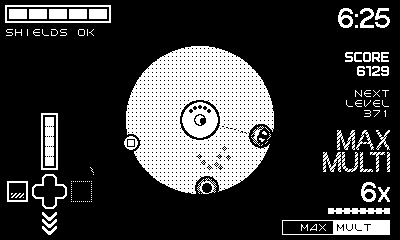
I first noticed this when digging into Fulcrum Defender, the new game from Faster Than Light and Into the Breach creators Subset Games. There’s just a lot packed into this game: lots of weapons, enemies, upgrades. It’s a very well fleshed out shoot-em-up. And while it’s small by the standards of Subset’s previous releases, you can tell that the team wanted to make something that feels complete in its own right.
Subset cofounder Jay Ma, who took the lead on Fulcrum Defender, told me she didn't set out to push the limits of the system, “but when you're making a game with lots of objects I naturally just wanna see how many you can get on the screen.”
Alas, the Playdate does have its limits, and at later stages of FD, with enemies swarming, you do encounter a bit of slowdown. “I definitely hit that wall pretty early,” Ma says, “but someone who was more familiar with how to write efficient code would certainly have gotten more out of the system. If I had no limitations, I probably would have made the endgame even more chaotic. Picture more cascading and interactive elements—shots splitting, bouncing, pushing enemies, etc.”
But the limitations inherent to the Playdate aren’t to be seen as a negative. “It helped me maintain focus on what was important,” she says, “and I learned a lot in the process of trying to optimize.”
Sidebar: A Q&A with Jay Ma of Subset Games
Faster Than Light and Into the Breach are two of the most beloved indie games of the past 15 years, so it’s a little shocking that the third release from the studio would roll out exclusively on the Playdate. I asked Jay Ma a few additional questions about the attraction and limitations of the device:
PUSH TO TALK: I really love how Fulcrum Defender demands precision, and the way it forces you to fully attend to every pixel on the screen. In some ways I think that sucks you in more completely and makes you forget you're playing on a 2.7-inch screen. I'm curious about the role precision plays in your work more broadly, and why you think it matters?
JAY MA: As a designer, the precision and kinesthetic joy of using the Playdate’s crank was what drew me to try and make a game for the device. What happens on screen when you move a mouse depends on all sorts of settings, so an input device with more accuracy than a joystick was very exciting for me.
I suppose this desire for precision and clarity extends to all our work. We want to make interesting challenges for the player when they have a full understanding of the game state. We do that by trying to be as transparent and clear with information as possible. This can be seen in the telegraphed attacks of enemies in Into the Breach and our attempt to show all game information in a single game screen in Faster Than Light.
Both prior Subset games had massive audiences. So I'm curious about how you think about the appeal for a designer of going smaller, and making something for a niche like the Playdate audience. How does that impact your design approach, and does it feel any different once the game is out in the world?
The process of developing the games is pretty similar—we start with the idea for an experience or mental state we want the player to be in, then generally work backwards to figure out game mechanics that would best achieve that goal. However, there are a lot of practical differences with developing for a small user base and a single device. You don't have to worry about the myriad types of computers out there, so testing is a lot simpler for example. All in all, the release process feels like a toned down version of releasing a full game—same type of excitement, anxiety, and post-release sadness—it's just not as strong and fades quicker. Frankly I hope I get to make more small games in the future. It's much easier on my nerves.
In general, we make games "selfishly." We try to create games that we ourselves would want to play, with the assumption that there's at least a few people out there who would enjoy it as well. We certainly add features and polish with the player in mind, but other than that I feel like I would want to make the same games even if they were never to be released. Frankly, I find the sheer number of fans of our games to be hard to mentally process. I struggle to picture numbers of people greater than 100, so having a million players enjoy the game or 10 thousand feels similarly positive—they're both abstract ideas I can't picture. I get to try to make games for me and my friends so everything else is just icing on the cake.
The Beauty of Limitations in The Whiteout
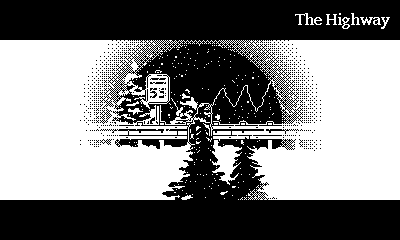
Another remarkably deep Season Two game is Steve Chipman’s The Whiteout, a sort of post-apocalyptic walking adventure inspired by The Road. It’s a surprisingly dark game, with a lot of death and horrifying moments. I’m usually not a fan of these sorts of slower-paced adventure games, but something about The Whiteout pulled me in, and I lost a couple of hours to it this week.
Chipman, who has released 10 games on the Playdate, told me in an email that he just loves “the problem-solving aspect” of game development. “I love that it lets me do all the things I really enjoy: solving hard problems and making art and music,” Chipman says. “Writing games for limiting platforms is a lot of fun too—I used to write games in JavaScript for fun way back in the Internet Explorer/Netscape days, long before JavaScript was ubiquitous, and the really enjoyable part of that was making the browser do something it wasn't meant to do.”
I asked Chipman whether he explicitly set out to make a “big” Playdate game with The Whiteout. His full response:
Absolutely. When I originally pitched the game, I said something along the lines of how one of my goals with it was to inspire other developers with what's possible on the device, in terms of breadth, visuals and storytelling. I hope I succeeded in that…
The limitations [of the Playdate] are a huge part of the appeal for me. I find it really fun to make something that looks really cool, try that really cool thing on the hardware, see that it absolutely tanks performance and then having to figure out how to optimize it so it doesn't. It's extremely satisfying. Finally getting a performant implementation of falling snow in a game about snow was a cause for celebration.
I've learned a lot about what makes for effective pixel art, as well as working at a small scale and little tricks to add details to things without muddying them or making them difficult to distinguish. Unique to 1-bit, there are things like dither flash and how to avoid it. Or finding a color palette I could use for art in The Whiteout that would dither to patterns that wouldn't flash as they passed through the transparent parts of the vignette, etc. You don't really have to consider things like that in an iPhone game, so it's a pretty unique set of challenges.—Steve Chipman, founder of Scenic Route Software
Go Big, Get Nuts
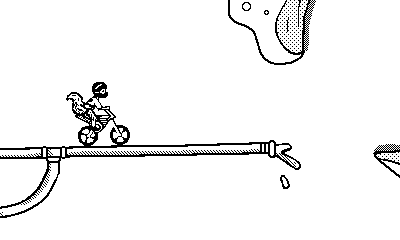
One of my favorite Playdate games is Gravity Express (2023) by Nino van Hooff. It was one of the early “big” games on the Playdate’s Catalog storefront, with lots of levels and replayability. So it’s fitting that one of the most satisfying and rich games in the Playdate Season Two lineup comes from van Hooff, in collaboration with illustrator and musician Julie Bjørnskov.1
According to van Hooff, the duo had already made progress on what became Wheelsprung when they received an offer to pitch for Playdate Season Two. They were also feeling ambitious, and were aiming to build something that pushed the Playdate to its limits. “It's more that I'm drawn to doing big projects rather than Season Two inspiring me to make it bigger,” van Hooff says.
The collaboration between van Hooff and Bjørnskov is a testament to the community Panic has built up around the Playdate. The two connected via the official Playdate Discord, and they still haven’t met in person, despite recently shipping their game together.
Both developers sang the praises of the broader Playdate dev ecosystem: “I think the Playdate Discord is a lovely community where my games have been really well received,” Bjørnskov says.
“The community is great, consisting of 30-somethings with a positive attitude,” van Hooff agrees. “I have great FOMO anytime Panic or the community organize in-person events such as a BBQ or garage sale.”
“It’s impressive how much Nino was able to get out of the Playdate,” Bjørnskov says. “I can’t quite remember how many levels we originally planned, but it ended up being quite a few more. I still have a lot of ideas and things I’d like to explore—especially in terms of new levels and the visual worlds players move through. But, I think we managed to cover a lot of ground, and the levels that are included have a good flow—both in terms of difficulty and the evolving artwork.”
The Art of Developing a Scene
A striking thing about the Playdate, as it enters its fourth year on the market, is how unusually rich the dev scene around the platform has become, despite the relatively limited reach of the platform itself. It’s been a little over a year since Panic confirmed they’d sold 70,000 units of the device, and although they recently announced that they’ve paid out just over $1 million to developers on the platform, that’s spread out across over 250 releases… so nobody is really in this for the money.
But still, it’s getting a lot harder to write off the Playdate. It’s not just some zany marketing stunt pulled by a bunch of quirky creatives in Portland. This is a real platform, with hundreds of developers putting serious effort into releases.
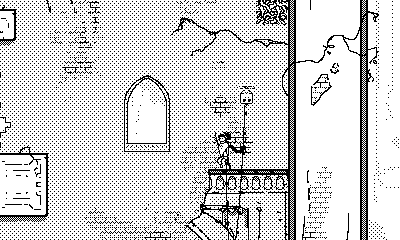
I think there’s a temptation, especially given that the device costs $229, to dismiss the Playdate as a mere toy. It’s easy to see why: It’s got a crank controller! And Panic’s own messaging is hardly self-serious. “We made Playdate just for fun,” they declare on the official website.
So sure, it’s fun. But Panic certainly seems to be putting a lot of work in on this thing. They’ve built up a dedicated community of developers, released hundreds of games, and have now stewarded multiple “seasons” of content for an audience that, while small, seems genuinely engaged and excited about whatever the company does next.
Given all that, it may be time for a critical reassessment of what Panic is building here. Slowly, gradually, the Playdate has evolved into something more like a large-scale, collaborative, physical version of UFO 50. It’s an alternate history Game Boy with dozens upon dozens of genuinely great games.
Panic has achieved something much bigger than they’re normally credited for—even if, by traditional industry yardsticks, the Playdate remains “small.”
That’s it for this week.
I’m gonna go stretch out a wiener dog.
I’m looking forward to Bjørnskov’s next game: a stunning-looking illustrated puzzle adventure game on Steam called Escape the Baby Alarm.



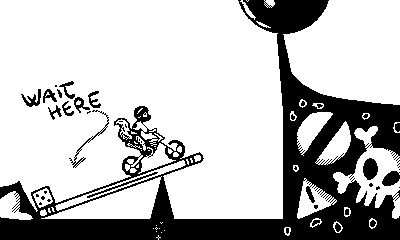
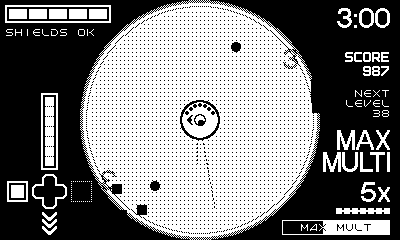
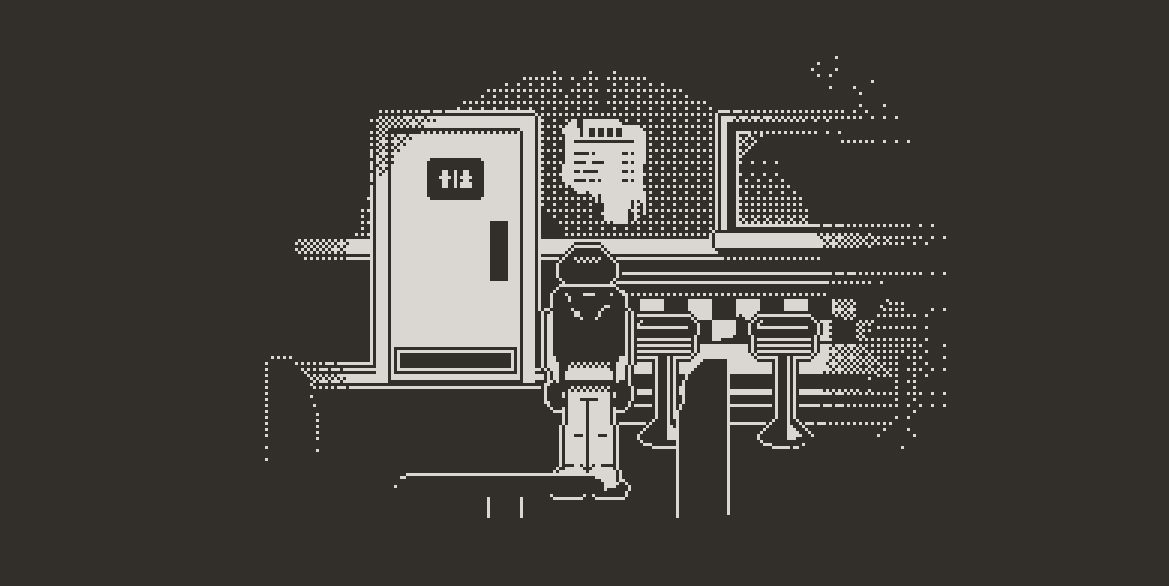
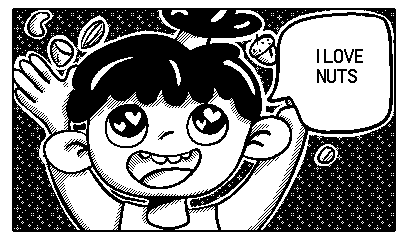

I'm a huge fan of limitation over expansion for games. It's why one of my favorite games of all time is Borderlands 2 on the Vita. The amount of optimization to port a whole console game to a handheld like that is WILD.
Same principle applies to the brilliance of late-life console releases like how God of War: Ascension looks like an early PS4 game.
Maybe I need more cranks in my game design!